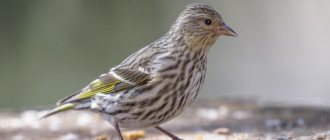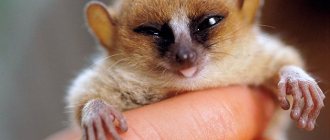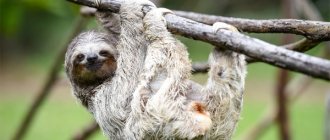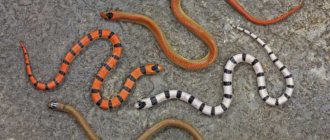Review author: “ZooVita”
Nature is structured in such a way that it amazes with its ability to create new species that surprise with their uniqueness not only in appearance, but also in behavior. Even representatives of the same infraorder may differ in size, lifestyle, and feeding habits. The animal lemur is a representative of mammals, the order Primates.
From 1999 to 2008, the number of distinguished species increased 3 times. They are unique because in the wild their habitat is concentrated in only one place on the planet.
General information about the animal Lemur
Lemurs are predominantly nocturnal animals. Despite many differences, monkeys are the closest relatives.
They have thick hair and an elongated body. There are different colors: black and white, brown, red, gray-brown (daytime animals are brighter). Slightly elongated muzzle with close-set large round eyes.
Like other primates, they have five-fingered limbs. The front ones have a well-opposable thumb, the lower ones have a long claw on the second toe to maintain hygiene.
Teeth: upper incisors widely spaced, lower incisors close to the canines. They have a large tail, equal in length to the body, and sometimes longer. It is a means of communication with each other, and also helps to hold on to branches when jumping.
The ancestors of lemurs lived in Africa. But over time, higher primates displaced them, and there was only one place left where the lemur lives - Madagascar and the Comoros Islands. Lemur-like creatures have colonized all areas with varied climates on the island.
The mythological side of the meaning of the lemur is interesting. The ancient Romans believed that the soul of a deceased person moved into this animal. There have always been many beliefs around primates, and even in world literature (the work “Faust”) lemurs were servants of hell.
Description and features
Lemur is an amazing living creature. Scientific classification attributes it to the wet-nosed monkeys. Unusual primates vary in appearance and body size. Large individuals of lemurs grow up to 1 meter, the weight of one primate is approximately 8 kg.
Relatives of the dwarf species are almost 5 times smaller, the mass of an individual is only 40-50 grams. The flexible bodies of the animals are slightly elongated, the outline of the head has a flattened appearance.
The animals' faces look like foxes. Vibrissae are located on them in rows - hard hair, sensitive to everything around. Open eyes of a yellow-red tone, less often brownish, are located in front. They give the animal a surprised, slightly frightened expression. Black lemurs have sky-colored eyes, rare for animals.
Most lemurs have long tails that perform different functions: holding on to branches, balancing while jumping, serving as a signal to relatives. Primates always monitor the condition of their luxurious tail.
Five fingers of the upper and lower limbs of the animals are developed for living in trees. The thumb is turned away from the rest, which enhances the tenacity of the animal. The claw of the second toe, increased in length, is used for combing dense fur, for which it is nicknamed the toilet claw.
The nails on the other fingers are medium size. Many species of primates groom their fur with their teeth—biting and licking themselves and their partners.
Thanks to their prehensile fingers and tail, lemurs are excellent tree climbers.
Lemurs, which live mainly in the crowns of tall trees, have forelimbs much longer than their hind limbs in order to hang and cling to branches. “Terrestrial” primates are distinguished, on the contrary, by their hind limbs, which are longer than their forelimbs.
The color of the animals is varied: grayish-brown, brown with a red tint, reddish. The black and white rows of fur on the spiral tail serve as decoration for the ring-tailed lemur.
In nature, primates of various species have a nocturnal and diurnal lifestyle. With the onset of darkness, dwarf species, thin-bodied primates, awaken. Terrifying screams and screams of communication between relatives terrify those who hear it for the first time.
There are many different types of lemurs, differing in appearance and color.
Indri lemurs are the most diurnal in terms of their habitat - they are often observed basking in the sun in thickets of trees.
Lemur indri
Lifestyle and character of Lemurs
Animals show aggression when defending their territory. As a rule, they live in family groups, headed by a female. It was she who had the honor of choosing a partner for the marriage period. In terms of nutrition, she also has an advantage over the male.
The lifestyle of some species of lemurs is terrestrial, but most others spend time in trees: there they make dens for themselves and give birth to offspring. Individuals can jump long distances from branch to branch. In such species, the forelimbs are larger than the lower ones. In those living on the ground, it is the opposite: the hind limbs are longer.
In groups the number of females and males is equal. It happens that males leave the pack and move to another or become loners.
To mark territory and prevent individuals from other family groups from entering, lemurs leave marks in the form of scratches on trees and smear the soil and tree with a special gland secretion.
When weather conditions become unsuitable for searching for food, animals either leave their habitat or go into hibernation. At a time of year when there is very little rainfall, some species go into torpor. The body obtains nutrients from stored fat.
Slow loris
The slow loris is a small animal that lives in Southeast Asia. The maximum height reaches only 36 centimeters, with a weight of up to 60 grams. They have a round head with a greatly shortened muzzle. Slow lorises have disproportionately large eyes, allowing them to see well in the dark.
The wool is printed but soft. As a rule, it has a brownish color with grayish spots. There is a dark stripe running down the spine.
The front and hind legs of these lorisiformes are approximately the same length. The pads are enlarged, all the fingers have sharp claws, with the exception of one – “cosmetic”.
Slow lorises consume a lot of protein. Their main diet consists of bats, small birds and their eggs. Slow lorises spend almost their entire lives at heights, which is facilitated by strong paws.
In its homeland, this subspecies is under threat of extinction, as it is considered a delicacy.
Interesting fact. Slow lorises have a very slow metabolism, so they almost never get poisoned.
What do Lemurs eat?
The diet is dominated by food of plant origin: seeds, leaves, fruits, for large species - tree bark, for small ones - plant resin, nectar of flowers.
Animals can also feast on animal food: larvae, beetles, spiders, frogs, as well as small birds and eggs from nests. When toxic plants come across, the animal lemur eats them with soil to neutralize the poison.
Their feeding method is similar to that of humans: they take food with their hands and put it in their mouth. The animals' diet is not nutritious enough, and they spend most of their time resting.
These creatures are brought to zoos, and sometimes exotic lovers keep them at home. The diet of the domestic lemur can be changed, but the animal's habits must remain.
Slender loris
The slender loris lemur is a small animal native to India and Sri Lanka. Like almost all representatives of loriformes, it is nocturnal. He leaves his house only after dark.
It feeds mainly on small insects. However, it can also hunt geckos, frogs and toads.
The lemur loris is a territorial animal. It lives in groups of up to 7 individuals and includes an alpha female and her offspring. They protect the boundaries of their territory from other representatives of the species.
Lemurs “slender lorises” do not form permanent pairs, but can even take care of someone else’s offspring. When the mother leaves the cub and goes to feed, the cub may be fed by other males.
At the moment, these species of lemurs are included in the Red Book, since there are only a few of them left. In the homeland of animals, it is forbidden to eat them.
Life expectancy and reproduction of Lemurs
Individuals live for about 20 years, but there are cases where animals lived up to 30-35 years. Different species have different breeding seasons.
Dwarf
- puberty at the age of 1.5 years;
- mating season from December to May;
- baby weight 3-5 g.
Large species
- puberty by 4-5 years;
- mating season in spring;
- baby weight from 80 to 200 g.
When the time comes to find a partner for procreation, the lemurs emit loud cries, the female rubs against the chosen one, marking him with her scent. Pregnancy lasts from 2 to 7 months, no more than once a year. In some cases, the female brings offspring once every 2-3 years.
1, less often 2-3 babies are born; a Varya can give birth to 4-6 babies. Hearing in newborns is not yet developed, but a grasping reflex is present. The eyes open on days 3-5. While the baby is very small, he holds tightly to his mother's abdomen.
Some species carry babies in their mouths, others keep them in secluded places - nests or hollows - for 2-3 weeks. Breastfeeding lasts from 4 to 5 months, after which the mature offspring become independent.
Basically, the animal lemur is prone to polygamy: harem families are created or partners change every year. Caring for the offspring falls entirely on the female. Only indri lemurs are monogamous: they remain faithful to their partner until his death, and the males take care of the babies.
Keeping at home
Recently, it has become fashionable to keep various exotic animals at home, including loris lemurs. Therefore, these animals, living in the natural environment, have a high chance of ending up in the networks of poachers who are engaged in catching and then selling such animals. In addition, animals suffer from human activities, who are active even in the most remote corners of our Planet, cutting down forest plantations in large quantities, which is why animals have to look for other habitats.
Content Rules
As a rule, living in the natural environment, these animals prefer to lead an isolated lifestyle, but when in captivity they prefer to live in pairs or as part of small groups. To provide these animals with comfortable living conditions, you will have to allocate enough living space for them by arranging a free enclosure. If you keep lemurs in a terrarium, you need to make sure that each individual has at least one cubic meter of living space.
It is also necessary to know that keeping several males in such conditions at once is associated with a number of serious problems. Firstly. Males begin to conflict with each other, which often leads to stress for some individuals, as well as the appearance of wounds and injuries of varying severity. In addition, males practice marking their territory with urine, which leads to the appearance of a persistent, unpleasant odor. At the same time, they update their labels quite often. If such marks are removed, this causes stress in the animal, and sometimes this leads to the death of the animal.
What to feed
When keeping lemurs at home, feeding ready-made dry factory food is associated with some problems. This is due to the fact that their diet should contain such foods as:
- Apples and also pears.
- Fresh carrots and fresh cucumbers.
- Melon or papaya.
- Kiwi, as well as half-ripe bananas.
- Raspberry and cherry.
- Quail eggs.
In addition, the diet should include insects in the form of caterpillars, dragonflies, crickets and cockroaches, as well as shrimp scalded with boiling water. Pets can be pampered with baby food in the form of cottage cheese, vegetable or fruit purees, nuts, crackers, milk, and unsweetened cookies.
Important to remember! Stressful situations, as well as disturbances in diet, lead to the development of a disease such as diabetes in the animal. If you do not pay attention to such a problem in a timely manner and do not take action, the animal will quickly die.
Rules of care
It is quite natural that not everyone who wants to have such a pet at home is able to create all the necessary conditions for keeping it. Therefore, many who have such an animal are surprised by its behavior, which boils down to the fact that the animal spends most of its time curled up in a ball. Many are surprised by the fact that animals can bite, and it is quite painful, provoking anaphylactic shock.
In addition to such disadvantages, many note the advantages of keeping such an animal at home. Among these advantages it is worth noting:
- No unpleasant odor coming from the animal's fur.
- Lemurs do not conflict with other pets.
- They do not need regular water treatments.
- Wool does not cause allergic reactions.
- These animals do not damage furniture, electrical wiring and other interior elements.
- There is no need to sterilize or castrate adults.
- There is no need for systematic nail trimming.
It is also necessary to remember that these wild animals are not tamed, so they can relieve themselves wherever necessary, do not respond to the nickname given to them, and at the same time bite strongly if they don’t like something.
Do lorises breed in captivity?
Adult lemurs become sexually mature at the age of 17-20 months, while females reach sexual maturity somewhat later, around 18-24 months. While in captivity, these animals practically do not reproduce, although such cases do occur. If in a natural environment a female becomes pregnant once a year, then in captivity she can become pregnant only once in her life, after which no more than two cubs are born.
Owners of such exotic animals point out that the female’s pregnancy is secretive and it is almost impossible to notice that she is carrying her future offspring. This becomes known only after the babies are born. Upon reaching six months of age, the cub should be separated from its mother, and after a year this cub will become an absolutely independent animal. If sufficiently comfortable living conditions are created for the loris lemur, then such a pet can live for at least two decades.
Types of Lemurs
Due to the fact that animals from the Lemur family live in different climate conditions of the island, many species have formed. According to 2014 data, 113 were recognized. They differ in external characteristics, lifestyle, nutrition, and reproduction. Here are examples of some of them.
Breed Madagascar hand-footed
Another popular name is aye-aye. The local population has a belief that whoever kills the little hand will soon die himself. For a long time this species was classified as rodents due to the similarity of teeth. The animal is active in the dark and is the largest among the “night lights” (body length reaches 40 cm, large tail up to 60 cm, weight about 3 kg).
Taking a photo of a lemur can be difficult, as it rarely comes to the ground. Color black with white specks. The eyes may be yellow, greenish or orange. The arm-foot feeds on larvae and beetles, which it takes out from the bark of trees. Habitat: jungle in the north of the island.
The animal is listed in the Red Book. Based on various sources, there are between 100 and 50 individuals. One of the problems is that this species reproduces no more often than once every 2-3 years.
Ring-tailed lemur
The island's natives call such animals katta or maki. These are diurnal individuals and, unlike the bat, lead a terrestrial lifestyle. Looking at the photo of the lemur, it becomes clear why it received the name “cat”. It has a large striped tail, gray color, limbs and belly are lighter than the back.
In size and sounds (meowing and purring) it resembles a cat. But if the animal is scared or in a state of excitement, it begins to squeal. The diet is dominated by plant foods, with occasional insects. They can move on both four and two hind limbs.
Lemur indri (babakoto)
Speaking of size, it is a leader. With a body length of 90 cm, it has a short tail - only 5 cm, weight 6.5-9.5 kg. A muzzle without hair, large fluffy ears and red lips. Wool with a white and black pattern. They live in trees, northeast Madagascar.
They differ in that they create monogamous couples. Indris are considered the noisiest. The basis of nutrition is leaves, less often fruits. Lemurs breed every 2-3 years.
Buy a lemur loris: tips
As mentioned above, recently it has become fashionable to keep unusual animals, including loris lemurs, in apartment conditions. Fashion is known to be ruthless and unforgiving. After the emergence of a huge demand for these animals, they began to be caught uncontrollably and transported to other countries for absolutely ridiculous money. These animals had a long journey ahead of them, and many of them did not survive, faced with hunger, cold and terrible living conditions. In this regard, it should be noted that acquiring an absolutely healthy animal in such conditions is almost impossible.
Important point! When choosing an animal, first of all you should pay attention to its appearance. High-quality coat, shiny eyes without any discharge, as well as strong teeth are evidence that this individual is quite healthy.
If an animal is purchased from a nursery, it must have all accompanying documents. Naturally, the cost of such loris starts at 50 thousand rubles. If you buy an animal from a private breeder, then its cost is within 10 thousand rubles.
LEMURE LORI IS AT HOME! RESCUE WILD PET FROM ASIA - UNUSUAL PETS
Enemies of Lemurs in the wild
Although agile, lemur-like creatures also have a harmless and timid nature. The threat comes from birds of prey (long-eared owl, fossa, hawks), mammals (domestic dogs, mongooses) and snakes.
The greatest danger is man. Deforestation, commercial hunting and the export of animals to zoos have a major impact. Lemurs cannot survive in other natural conditions outside the island.
The species was declared at risk of extinction in 2022. The International Union for Conservation of Nature has taken animal welfare measures such as habitat protection as well as ecotourism to stop recreational poaching.
Where to see the miracle beast
The nocturnal lifestyle, secrecy, caution and timidity of lorises make observing them in the wild a difficult task. In captivity, you don’t really look at the animals either:
- Firstly, they are very impressionable, fastidious in their maintenance, easily injured, susceptible to stress, and contract infections. In general, they do not tolerate being outside their natural environment well. Because of this, only 28 zoos in the world can boast of such guests. And the menageries where the animals gave birth can be counted on the fingers of one hand.
- Secondly, lorises sleep during the day. Even if you get to the menagerie where these little ones live, the chance of seeing them is extremely small.
Therefore, the best way to watch an exotic animal is through specialized video channels, Discovery, National Geographic or Nat Geo Wild programs.
Entertaining videos on YouTube with inviting titles like “Cute slow loris eats a banana” or “Scratch the lemur” are unlikely to please you when you find out the other side of the touching picture.
Photos of all types of lemurs
Home maintenance
For the first time, while the baby gets used to the new home, he will spend all his time in the cage, so choose a spacious cage with several hiding places. The ideal option is an aviary.
Lemur in a cage
The material does not matter - the rods can be metal, plastic or wood. The cage should have separate bowls for food and water, also made of any material. The water must be changed regularly, a couple of times a day.
In the cage itself, it is advisable to recreate a natural landscape - branches, small trees, you can make a nest on a tree (for example, an old earflap hat), but it is better to have a closed house where the animal will hide. But you can’t clutter it up, lemurs have bursts of energy, they start running and jumping very actively, and there should be enough spacious space.
Once a month it is necessary to carry out general cleaning, wiping everything with a damp cloth. But natural waste products will have to be removed every day, and more than once.
It is best to place the cage in a calm, quiet place where there are no drafts, heaters, or direct sunlight. It is also recommended to purchase a weak UV lamp, which you can turn on during the day for a couple of hours.
Of course, when the baby gets comfortable and stops being afraid, you can let him walk around the apartment, gradually accustoming him to holding hands. The loris does not get along with other domestic animals and is also wary of children.
Diet
Lemurs feed on both plant and animal foods:
- Insects;
- Chicken fillet;
- Porridge;
- Dairy products;
- Vegetables fruits;
- Mealworms;
- Chicken eggs;
- Bread.
If the lemur refuses to eat, then coat the food with honey, they adore it.
Lemur eats a grasshopper
For balance, you need to adhere to the rule - a third of the diet is insects, a third is porridge and sour milk, and a third is vegetables and fruits. If there is too little or too much of some food, the lemur will get sick.
By the way, insects can be frozen in the freezer in the summer, thereby saving them for future use throughout the winter.
You shouldn’t offer them food from our table; allergies or intestinal disorders are possible.
Try to feed it by hand, thereby establishing contact so that the animal does not see you as a threat.
And remember - we are responsible for those we have tamed!











